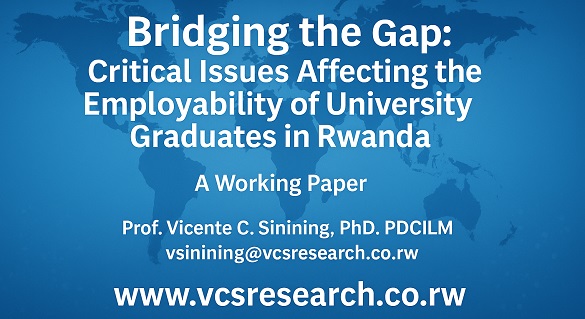
Abstract
In recent years, the question of graduate employability has gained renewed urgency in sub-Saharan Africa, particularly in rapidly developing nations like Rwanda. Despite significant strides in expanding access to higher education, a persistent disconnect remains between university training and labor market demands. This study investigates the critical issues affecting the employability of university graduates in Rwanda, drawing on a mixed-methods approach that combines survey data from recent graduates and interviews with employers, policymakers, and university administrators.
The findings reveal that a major barrier to graduate employability lies in the mismatch between academic curricula and the competencies required in the workforce. Inadequate practical experience, insufficient soft skills training, and limited industry engagement further exacerbate the problem. Gender disparities and sector-specific employment bottlenecks are also examined. Grounded in human capital and employability skills frameworks, the study underscores the need for systemic reform through stronger university-industry linkages, competency-based curriculum design, and institutional career support services.
The paper concludes with targeted recommendations to enhance policy coherence and align educational outcomes with national development goals. These findings offer valuable insights for stakeholders aiming to bridge the skills-employment gap in Rwanda and similar contexts across the Global South.
Keywords: Employability, Higher Education, Rwanda, Skills Gap, Graduate Outcomes, Human Capital, Workforce Development
1. Introduction
1.1 Background and Context
The rising number of university graduates in Rwanda reflects a commendable commitment by the government to expand access to tertiary education as a strategy for socio-economic transformation. Rwanda’s Vision 2050 and its National Strategy for Transformation (NST1) both underscore the role of skilled human capital in advancing national development goals. Yet, even as higher education institutions produce more degree holders annually, the economy has struggled to absorb this growing cohort. Unemployment among university graduates remains disproportionately high, signaling a troubling paradox: a country investing in education yet failing to translate that investment into productive employment.
1.2 Statement of the Problem
Despite the growing supply of graduates, many employers report difficulty in finding candidates with the requisite skills for modern, technology-driven workplaces. This suggests a structural misalignment between university training and the realities of the labor market. Graduates frequently lack work experience, technical proficiency, problem-solving capacity, and effective communication skills—competencies now essential across sectors. This disconnect threatens not only the livelihoods of young people but also Rwanda’s broader development ambitions, as human capital is a central pillar of its economic growth strategy.
1.4 Objectives of the Study
The primary objective is to identify and analyze the critical issues hindering the employability of university graduates in Rwanda. Specific objectives include:
- Examining the extent to which higher education curricula address market-relevant skills;
- Assessing employer perceptions of graduate readiness for the workplace;
- Proposing strategic interventions at institutional and policy levels.
1.5 Significance of the Study
This research offers vital insights for universities, policymakers, employers, and development partners working to enhance education-to-employment pathways in Rwanda. By systematically mapping the obstacles to employability, the study aims to inform evidence-based strategies that can support sustainable workforce development and inclusive economic growth.
1.6 Organization of the Paper
Following this introduction, Section 2 provides a comprehensive literature review on graduate employability in the African context. Section 3 outlines the methodological approach used. Section 4 presents the findings, while Section 5 discusses their implications in light of existing theories and prior studies. The paper concludes in Section 6 with policy recommendations and suggestions for future research.
Click here to read the full paper.
Click here to go back to the list of publications.












